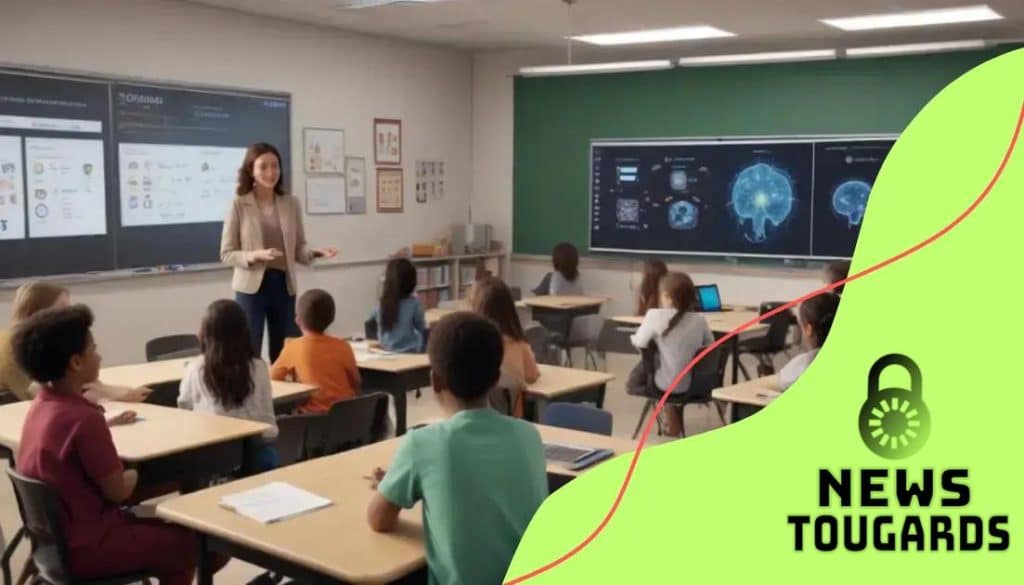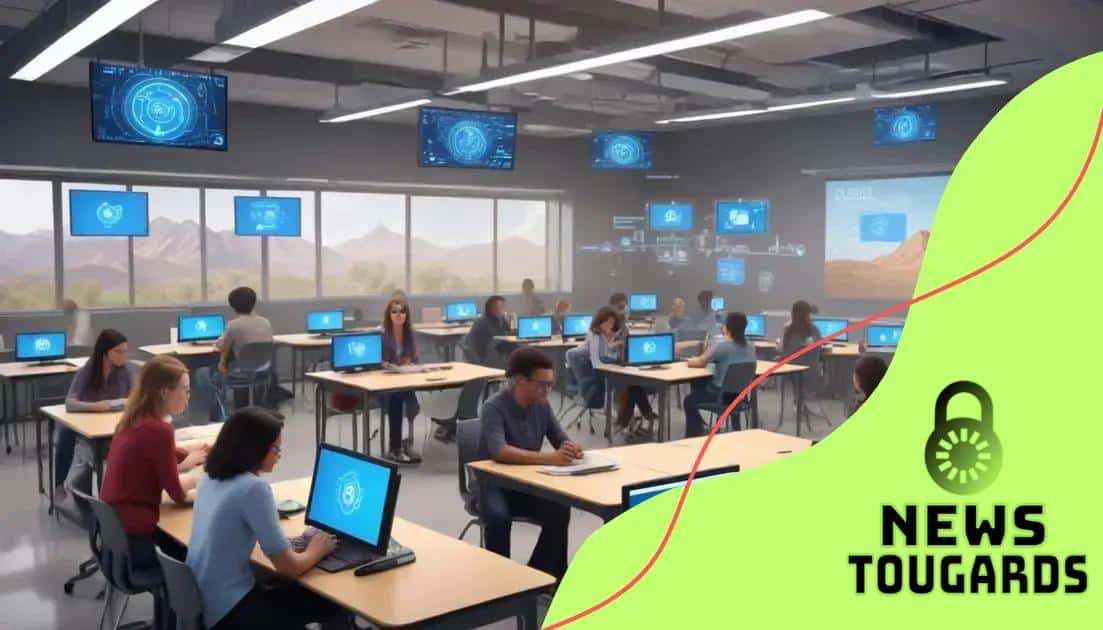Teacher AI training: transforming education for better results

Teacher AI training enhances educational experiences by personalizing learning, improving engagement, and integrating innovative technologies, ensuring that educators are equipped to navigate modern classrooms effectively.
Teacher AI training is reshaping the educational landscape, offering teachers new tools and methodologies to engage their students effectively.
Imagine being able to tailor learning experiences that cater to individual needs. Let’s explore how this groundbreaking approach can revolutionize teaching.
Understanding Teacher AI training
What is Teacher AI Training?
Teacher AI training provides educators with the knowledge and skills needed to integrate AI into their classrooms.
By learning about AI, teachers can create more personalized learning experiences for their students.
This training often covers topics like data analysis, adaptive learning technologies, and how AI can automate administrative tasks.
Benefits of Teacher AI Training
There are numerous advantages to undergoing Teacher AI training. Here are just a few:
- Enhanced Student Engagement: With AI tools, teachers can create interactive lessons that capture students’ attention.
- Personalized Learning: AI helps tailor education to meet the unique needs of each student, improving their learning outcomes.
- Time Saving: By automating routine tasks, teachers can focus more on teaching rather than paperwork.
Furthermore, understanding the impact of AI on educational practices allows teachers to embrace innovation.
As they become more familiar with these technologies, they can adapt their teaching styles and materials to better prepare students for the future.
This can also lead to greater job satisfaction as teachers feel more equipped to meet the demands of modern education.
Challenges in Understanding AI
While Teacher AI training comes with many benefits, there are challenges to consider.
Some educators may face difficulties in navigating new technologies or may require additional support to implement AI solutions effectively. However, with proper training and resources, these challenges can be overcome.
Incorporating AI into teaching is not just about learning new tools; it’s about understanding their potential impact.
As teachers delve deeper into this realm, they uncover the possibilities of transforming education into a more dynamic and engaging environment for students.
Benefits of AI training for educators
The benefits of AI training for educators are vast and can significantly improve both teaching and learning experiences.
When teachers undergo this training, they gain valuable insights into how to effectively use AI tools in their classrooms.
This can lead to more tailored educational experiences that cater to individual student needs.
Key Advantages of AI Training
There are a few remarkable advantages that come with AI training:
- Improved Engagement: Interactive AI tools can enhance student participation and interest in lessons.
- Personalized Learning: AI enables educators to create customized learning paths for each student, addressing their unique learning styles.
- Efficiency: Automating administrative tasks allows teachers to spend more time on instruction rather than paperwork.
Moreover, by understanding AI technologies, educators can transform their teaching practices to integrate innovative approaches.
This gives students access to a richer learning environment that promotes curiosity and exploration.
Teachers who embrace AI can also collaborate more effectively, sharing resources and best practices with colleagues.
Long-Term Impact
Over time, the growth of technology in education shapes the overall learning experience. By investing in AI training, schools can foster a culture of continuous improvement, where teachers and students thrive.
This training not only benefits individual classrooms but also contributes to the evolution of the entire educational system.
In this way, AI training empowers educators to become more effective and adaptable in a rapidly changing world.
Key components of effective AI training

Key components of effective AI training play a vital role in ensuring that educators gain the necessary skills and knowledge.
This training should be structured, comprehensive, and focused on real-world applications that educators can immediately implement in their classrooms to improve instruction, engagement, and student outcomes.
Understanding these components can help schools design programs that maximize the benefits of AI.
Essential Elements of AI Training
Effective AI training consists of several key elements:
- Hands-On Experience: Practical exercises allow educators to apply what they learn in real classroom scenarios.
- Ongoing Support: Continuous assistance from experts can help teachers navigate challenges as they integrate AI tools.
- Collaboration: Opportunities for educators to work together fosters sharing of strategies and best practices.
Moreover, a strong curriculum is crucial for covering all necessary topics. This should include not only the technical aspects of AI but also the ethical considerations involved in using technology in education.
Training programs must be adaptable to fit different teaching styles and school environments.
Curriculum Focus
A well-designed AI training curriculum focuses on several crucial areas. First, understanding AI fundamentals is essential.
This includes algorithms, data processing, and how these elements can be leveraged in the classroom. Additionally, educators should learn about specific AI applications tailored for educational purposes.
Furthermore, incorporating feedback mechanisms is critical for assessing progress and improving training.
Gathering insights from teachers about their experiences with AI ensures that the training remains relevant and valuable. The synergy of these components reinforces the overall effectiveness of AI training programs.
Real-life examples of AI in education
Personalized Learning Platforms
One of the most notable and impactful applications of AI in education is personalized learning.
Advanced platforms like DreamBox and Knewton utilize real-time data analysis to assess student performance and adapt instructional content to meet individual learning needs.
By tailoring lessons to each student’s strengths, weaknesses, and pace, these systems create a customized educational experience that can significantly boost comprehension, retention, and overall academic confidence.
AI Tutors and Assistants
AI-driven tutors, such as ChatGPT and IBM Watson Tutor, provide additional support for students outside of the classroom.
These intelligent tools can answer student questions in real time, explain complex concepts in simpler terms, and even provide detailed, constructive feedback on assignments, all of which support more effective and independent learning.
This 24/7 availability allows students to learn at their own convenience, making education more accessible.
Grading and Assessment Automation
AI is also helping to streamline grading and assessments. Tools like Gradescope use algorithms to evaluate student submissions faster and more accurately than traditional methods.
This allows teachers to focus more on teaching rather than getting bogged down with paperwork.
Lastly, AI tools can analyze data to provide insights into student performance, helping educators identify areas for improvement.
Transitioning to a classroom enriched with AI also paves the way for innovative project-based learning.
For example, schools using AI-driven simulations in STEM subjects help students visualize complex concepts. Such applications enhance engagement and make learning more enjoyable.
These real-life instances highlight the effectiveness of AI in education. As more schools adopt these technologies, the potential for enhanced learning outcomes will undoubtedly grow.
Challenges in implementing AI training
Implementing AI training in schools presents several challenges that must be carefully addressed to ensure successful and sustainable integration.
These obstacles can range from limited resources and lack of technical expertise to resistance to change and concerns about data privacy.
Understanding and proactively tackling these issues is crucial for educators, administrators, and policymakers who aim to create an environment where AI can enhance teaching and learning without compromising educational values or equity.
Resistance to Change
One significant challenge in implementing AI training is the resistance to change among educators. Many teachers may feel more comfortable relying on traditional teaching methods and may be hesitant to incorporate unfamiliar technologies into their classrooms.
This reluctance often stems from a lack of understanding of how AI tools work and the practical benefits they can offer.
Without proper guidance, AI may seem intimidating or unnecessary. It is essential to provide comprehensive training and clear examples of success.
Ongoing support is also crucial to help teachers build confidence and embrace these innovations as tools that enhance, not replace, their role in education.
Lack of Resources
Another major hurdle is the lack of resources. Schools often face budget constraints that limit access to the latest AI technologies and training programs.
Without sufficient funding, it can be difficult to provide teachers with the tools and training they need.
Additionally, many schools lack the infrastructure to support advanced digital technologies, such as reliable internet access, updated hardware, and dedicated IT staff.
Training Quality
The quality of AI training programs can vary significantly. Some may not provide the necessary depth or hands-on experience needed for educators to feel confident in using AI effectively.
Schools should seek out comprehensive training options that cover key components, including practical applications and ongoing support.
Furthermore, integrating AI tools into existing curricula can present challenges. Educators may struggle to find ways to harmonize traditional lesson plans with new technologies.
This requires careful planning and collaboration among faculty members to create a cohesive learning experience.
The perception of AI in education can also pose challenges. Some educators may worry that these technologies could replace their roles rather than enhance them. It is essential to emphasize that AI is a tool designed to support teachers, not replace them.
Future trends in teacher AI training

Future trends in teacher AI training promise to reshape the educational landscape even further, offering new ways to support both teachers and students.
As technology continues to evolve, so does the approach educators take to learn, implement, and adapt to these innovations.
From real-time analytics to immersive simulations, these advancements are paving the way for more dynamic, responsive, and personalized teaching strategies.
This continuous change opens up exciting possibilities for improving classroom experiences, enhancing student outcomes, and redefining the role of educators in the digital age.
More Personalized Training Programs
One emerging trend is the move toward more personalized training programs.
Just like how AI tailors learning experiences for students, future training for teachers will focus on individual needs and learning styles.
This means creating customized pathways that allow educators to engage with AI tools that align with their specific subjects and teaching methods.
Integration with Data Analytics
Another significant trend involves the growing integration of data analytics into teacher training programs.
By collecting and analyzing data on teacher performance, student engagement, and learning outcomes, training modules can be adjusted in real time to better align with the specific needs of classrooms.
This data-driven approach enables more targeted and responsive professional development, helping to ensure that educators receive training that is both relevant and impactful in addressing the real challenges they face in modern educational settings.
Collaboration and Community Learning
The concept of collaboration in learning is also set to expand. Online platforms will enable teachers to connect with peers from around the world, sharing experiences and best practices related to AI tools. This community-driven approach fosters a culture of learning and continuous improvement.
Additionally, as AI technology becomes more accessible, we can expect to see an increase in resources available for teachers.
Online courses, workshops, and webinars focusing on practical skills will empower educators to become confident users of AI.
Furthermore, partnerships between educational institutions and tech companies may lead to more comprehensive training solutions that incorporate the latest advancements in AI.
As these trends develop, the landscape of teacher AI training will continue to evolve, preparing educators to navigate a modern classroom that increasingly relies on technology.
This dynamic environment enables teachers to provide enriched educational experiences for their students.
FAQ – Frequently Asked Questions about Teacher AI Training
What are the main benefits of AI training for teachers?
AI training helps teachers personalize learning, engage students better, and improve teaching efficiency by automating administrative tasks.
What challenges do educators face when implementing AI training?
Challenges include resistance to change, lack of resources, and the need for high-quality training programs.
How can AI tools enhance student learning experiences?
AI tools provide personalized content, immediate feedback, and interactive learning opportunities, making education more engaging.
What future trends are expected in teacher AI training?
Future trends include personalized training programs, integration with data analytics, and increased collaboration among educators.





